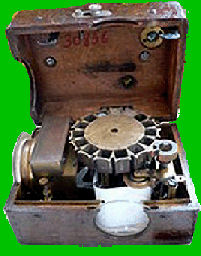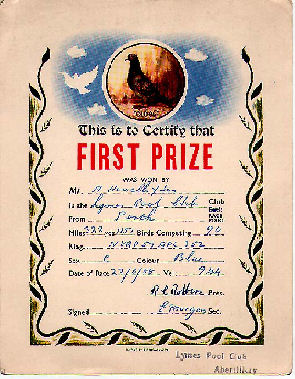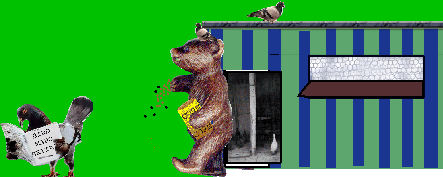Lecture Programme
Just a reminder that from March we are resuming a monthly lecture programme but in response to our members’ views the lectures will take place on the first Wednesday of the month, starting at 2pm, in the office at the Museum. We hope an afternoon slot will encourage a good attendance. Space is limited and so we will need to have an idea of numbers; if you are coming to a lecture please call at the Museum for a ticket or ring to reserve a place. Entry will be £2.
100 Club – February
To be drawn in March.
Fund raising February - £418
Oxford House day school
You will see from ‘Diary Dates’ that on Saturday 2 nd April, Oxford House Industrial History Society are holding their day school at Llanhilleth Institute between 9.15 and 4.30. The fee is £17.50/£18.50 including lunch and tea. More details at the Museum.
Laurence Hale articles
Museum Society member, Mr Laurence Hale, regularly contributes his well researched articles on topics of local interest. We are only able to publish edited versions and so if you would like to read the original articles in full, please contact the Museum. In the meantime, we are sure you will enjoy this month’s article on ‘The Powell Brothers and Abertillery’.
Diary Dates
Wednesday 2nd March – Wartime Rationing by Margaret Gilson 2pm at the Museum
Saturday 5th March – St David’s Day Coffee Morning – bring your Welsh Doll
Mid March – late April – ‘My Valley House’ an exhibition by the Heritage Lottery Fund
Saturday 2nd April – Town Twinning table top sale, Abertillery
Saturday 2nd April – Oxford House Industrial History Society Day School , Llanhilleth Institute
Wednesday 6th April – ‘Then and Now in Photographs’ by Don Bearcroft, 2pm at the Museum
Wednesday 4th May – Ralph Robinson Memorial Lecture ‘Medieval Herbs and Medicine’ by Adrianne Jones, 2pm at the Museum
Spring Raffle
We will, as usual, be organising a spring raffle which will be drawn at the Memorial Lecture in May. Can you please help with raffle prizes- hamper items etc.
The Powell Brothers and Abertillery
There was always an element of gamble about investment in the early coal trade, but by his singleness of purpose and shrewd decisions, Thomas Powell had established himself as the undisputed leading figure in the 19 th century South Wales coal trade.
His third wife bore his sons Thomas Jnr., Walter and Henry. They were introduced into the Company but Thomas Senior maintained strict control, despite deafness, until his death on 24 th March 1863 aged 83.
Under the terms of his will, his vast property in mining, railways, canals, timber and shipping passed to his three sons who soon concluded that they were ill-equipped to manage such a large enterprise. Thomas Jnr. decided to give up his interest in steam coal and concentrated on a small number of house coal pits in Glamorgan. Walter and Henry commissioned eminent engineers, including George Elliot, to value their steam coal properties. A figure of £365,000 was established – equivalent to £20 million at 2011 values. George Elliot had been impressed by the steam coal collieries and decided to bid for them. His purchase offer at the valuation price was accepted and a limited company was registered on 28 th July 1864 under the name of the Powell Duffryn Steam Coal Co. This company would acquire and work Lower, Middle and Upper Duffryn, Abernant-y-Groes, Abergwawr and Cwmdare collieries in the Aberdare Valley and New Tredegar colliery in the Rhymney valley. The nominal capital of £500,000 was divided into 100 shares at £5000 which were taken up by nine subscribers including George Elliot. The subscribers were all known to each other and it had now become acknowledged that the considerable costs of sinking deep shafts and equipping new collieries required the additional resources of a Joint Stock Company.
The company was well led by George Elliot and possessed adequate working capital but it soon encountered severe marketing conditions in 1868-69 and for a period its future was in grave doubt. The situation slowly improved and the coal trade began to revive until by 1913 the South Wales coalfield produced 57 million tons of coal with 233,000 employees, its best year ever. The company grew in size and became a major player in the industry, noted for its progressive development strategy, a position it was to hold until nationalisation in 1974.
What of the Powell brothers with their new found wealth and their remaining interests in mining, transportation, timber and shipping? Walter and Henry were locally the principals of Powells Tillery Steam Coal Co who operated Tillery, Gray and Vivian collieries and were a major employer in Abertillery. The brothers bought this company in 1904 but much earlier, in 1860/70 Walter Powell had sunk No. 1 pit Llanhilleth, and in 1890 the brothers purchased Aberbeeg North colliery and built the single storey Powells Terrace, now demolished, to house their workers. The brothers lacked the drive of their father and they developed other interests.
In the early 1850s Thomas Powell Snr. had paid for a large dwelling called Coldra House to be built east of Newport, for his eldest son. This later became the Lydia Beynon Maternity Home and more recently the basis for the Celtic Manor Resort. Thomas Jnr, his wife and seven year old son were killed by natives in Abyssinia (now Ethiopia) when Thomas Jnr. was 35. Henry mounted an expedition to punish the guilty natives and retrieve his brother’s remains for burial in the family vault at Bassaleg. Henry had taken up residence in Ireland but later moved to Cirencester where he died, aged 56, from the kick of a horse.
On the death of Thomas Snr., the third son Walter, who never married, moved with his mother to Wiltshire and aged 26 was elected M.P. for Malmsbury. This was a time when ballooning was becoming popular and Walter became a keen balloonist, initially flying with friends and then constructing his own craft. On 10 th December 1881 he accompanied Captain James Templer, an experienced army balloon pilot, together with a Mr Agg-Gardner in the well constructed balloon ‘Saladin’ on a flight to study cloud movement and temperature for the Meteorological Office. The group set off from Bath in a south westerly direction intending to put down at Symonsbury some one and a half miles from the sea. While on a controlled descent Walter inexplicably threw out ballast causing the balloon to rise. In an attempt to retrieve the situation Templer pulled the gas valve allowing descent once more and looked for a suitable landing place. The balloon car struck the ground near Bridport and Templer and Agg-Gardner were thrown out but Powell for some unexplained reason remained. The balloon, now lighter, rose in the air. Powell waved and was last seen travelling seawards. It was hoped that the balloon may have reached the Channel Islands but no trace was ever found of Walter Powell or ‘Saladin’ and a subsequent inquiry blamed him for the crash.
Laurence Hale
Poet’s Corner
‘Waunlwyd’
Waunlwyd and Victoria, on the left and right The bottom end of RTB and colliery there in sight Empties from the steelworks, would trundle down the bank
Then put into sidings, like soldiers rank by rank Colliery turned out steam coal, the locos they would drive
Sent all around the country, the railways kept alive Lime poured down a channel, in River Ebbw went To neutralise the acid, the tinning plant had sent Turning that old river, a dirty looking brown The people of the valley, would look at it and frown
In Glan Ebbw Terrace, it was a common sight But they never did complain, just put up with their plight
From Victoria Station, past the Park Hotel A cottage on the mountain, a strange old tale would tell
Back in 1936, the cottage was quite scary Ghostly presence there was felt, made all the village wary
A festival of great repute, then to the village came A site that showed great beauty, gave the village fame
The colliery had gone then, the miners and the coal Steam had turned to diesel, Waunlwyd paid the toll
But they can’t take the spirit, through all the years of strife The people stick together, that is the valley life.
Dagworth Orville Charters
Chepstow War Memorial
If you go to Beaufort Square in Chepstow town centre you will see the 1921 War Memorial by Eric Francis of Chepstow and a 105mm gun from a First World War German U-boat. The gun is the only ‘war memorial’ gun in the United Kingdom. King George V presented it to the town in recognition of the Victoria Cross awarded to Chepstow seaman William Charles Williams. On 25 th April 1915 during the landing on V Beach, Gallipoli, Williams and three other men were assisting the commander of their ship, HMS River Clyde, at the work of securing the lighters. He held on to a rope for over an hour, standing chest deep in the sea, under continuous enemy fire. He was eventually dangerously wounded and later killed by a shell whilst his rescue was being carried out. His commander described him as the bravest sailor he had ever met.
Wedding Rings
Did you know that in 1549 it was decreed by King Edward VI that the third finger (counting from the right, excluding the thumb) on the left hand be known as the official ring finger. Also in 1549, the Book of Common Prayers designated the left hand as the marriage hand and that in this country such rings should be worn on the left hand. Wedding or betrothal rings have a long history and were known to have been used by the ancient Egyptians; the earliest rings were made of hemp and renewed each year.
Ancient Chinese Rock Carvings
This exhibition at the National Museum in Cardiff is well worth a visit. It is quite a small exhibition – just one room – but it contains a stunning display of sculptures from temples which were carved directly into sandstone cliffs near Chongqing as far back as the 7 th century. The sculptures on display are examples which have become detached from their original setting along with some replicas. They give a hint of the spectacle of over 50,000 statues to be seen at seventy five sites in the Dazu World Heritage Site. Many of the sculptures have never before been seen outside China. The exhibition runs until 3 rd April.
Book Corner
Understanding Welsh Place Names by Gwili Gog, price £7.99 This innovative paperback does what it says!
Strike for a Kingdom by Menna Gallie, £8.99 The secrets and tensions pf a close knit mining community as exposed in the reprint of this ‘outstanding detective story’ set at the time of the miners’ strike in 1926.
A Photographic History of Mining in South Wales by John O’ Sullivan, £9.99 A recent (February 2011) publication likely to be of interest!
Hats Wanted!
We need ladies’ and men’s hats for the dressing up box. Please have a rummage and bring your unwanted hats to the Museum.
Museum Matters
The Miners Racehorse
When I was young living at Panty-y-Pwdyn I remember that on the weekends the air was filled with the sound of shouts of men calling, “Come on”, “Come on”, the sound of wings and the cooing of the birds. It was the Pigeon Racing season! There were six Pigeon Cots around where we lived it was a popular sport amongst the working class especially to the miners of the South Wales Valleys.
Pigeon racing is the sport of releasing specially trained racing pigeons, which then return to their homes over a carefully measured distance. The time it takes the animal to cover the specified distance is measured and the bird’s rate of travel is calculated and compared with all of the other pigeons in the race to determine which animal returned at the highest speed. It requires a specific breed of pigeon bred for the sport, the "Racing Homer". Competing pigeons are specially trained and conditioned for races, the winner of a pigeon race is the bird with the highest velocity, measured in ypm/mpm; this calculation demands that the distance be divided into yards, divide the yards by the number of seconds it took the bird to return, then multiply by 60. Therefore Races can often be won and lost by seconds, and to measure this, many different timing apparatus have been developed. The traditional timing method involves rubber rings being placed into a specially designed clock.
The traditional method of timing racing pigeons involves rubber rings with unique serial numbers and a specially designed pigeon racing clock. The ring is attached around the bird’s leg before being sent to race. The serial number is recorded, the clock is set and sealed, and the bird carries the ring home. When the first bird returns, its trainer removes the ring and places it in a slot in the clock. The time that the ring was placed in the clock  is recorded as the official time that the competing bird arrived home. From this timestamp an average speed is measured and a winner of the race can be found.
is recorded as the official time that the competing bird arrived home. From this timestamp an average speed is measured and a winner of the race can be found.
My father who repaired clocks and watches and also did work for a well known jeweler in town was approached by some pigeon fanciers and offered money to fix a pigeon clock for a big race! He refused while at the same time telling them exactly what he thought of them!
Their journey home was fraught with perils; the main hazard encountered by racing pigeons is predation by birds of prey. The Peregrine Falcon is a major predator. Racing pigeons rely on the earth’s magnetic field which if disrupted by violent storms could disorientate the birds. Pigeons flying into electricity pylons or TV aerials can also prove fatal.
The pigeon cots were painted with bright, coloured, wide stripes or a checkered design to enable the pigeons to identify them when returning home. Even so some birds arriving settled on roof crests, hence the calling and rattling of corn tins to coax the birds down. Some men in their frustration would throw small stones which could be heard rattling down our slates, it stopped when my father appeared at the door. (Knowing it is going to have the ring removed speedily, which may be uncomfortable, the pigeon could be reluctant to enter the loft for the trainer).
For short races and training the birds were transported by van but for long distances they were sent by train. I can remember the pigeons “cooing” in their baskets on Abertillery Railway Station, (“Coo, he’s running late today Bill”. “Coo, about 10 minutes Sid”). They were sent as far away as Perth in Scotland 322 miles away.

Pigeon fanciers proud of their prize winning birds would not only display their cups and trophies they would have its portrait painted in oils, as did my uncle Fred Howells.

It is still a popular sport the latest development and preferred method for timing racing pigeons is the Electronic Timing System. The bird's arrival is recorded automatically at the loft. To clock the birds they are fitted with a band that has a tiny RFID chip in it which can be read when the bird comes home. At the home loft the electronic scanning records the pigeon’s arrival. The pad or antenna is placed at the entry point to the loft entrance and as the pigeon crosses it the electronic band is scanned
Don Bearcroft curator

